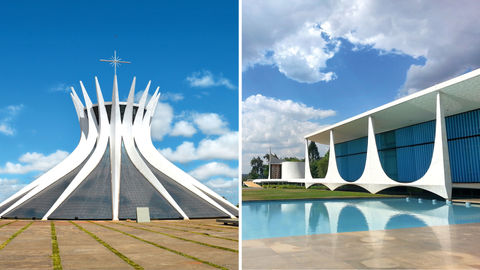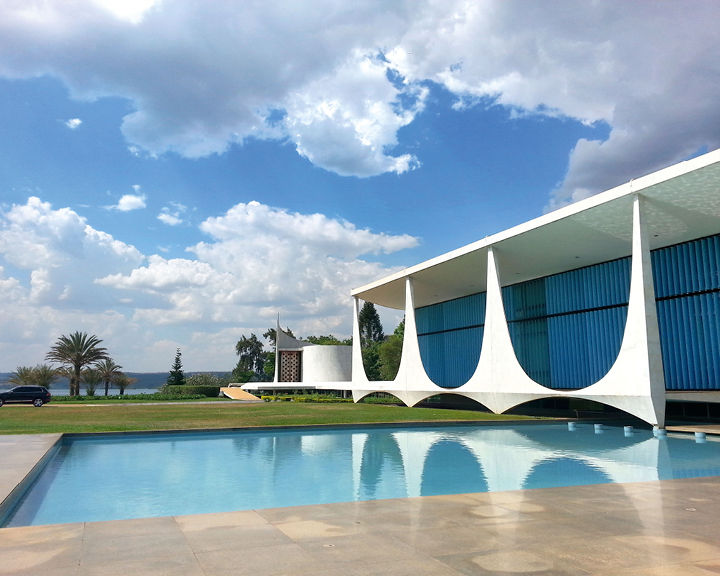
Brazil‘s capital used to be seen as an example of what went wrong with Modernist urbanism. But 60 years after its founding, we find a Brasília that is very much of, and for, the people. By Michael Snyder

Lúcio Montiel was the third child ever to be born in Brasília’s Base Hospital. It was 1960, and after four years of construction, the city had just formally opened as the centre of Brazilian bureaucracy. Montiel’s parents, like so many others from across the country, had chosen to arrive early, leaving the then-capital, Rio de Janeiro, to take part in this wildly optimistic experiment—a Modernist fantasia of a city willed into existence by the leftist president Juscelino Kubitschek, the architect Oscar Niemeyer, and the visionary city planner Lúcio Costa, the man after whom Lúcio Montiel was named. Today, Montiel works as a guide for the city and surrounding region. He met me on a bright blue morning in February, before the pandemic had hit Brazil, at the recently opened B Hotel (doubles from INR7,345). Its wood-panelled interiors, designed by the São Paulo–based architect Isay Weinfield, are a nod to the slick, high-modern aesthetic of Niemeyer.
Over the course of the morning, Montiel and I visited Niemeyer’s institutional structures along the grand central esplanade, better known as the Monumental Axis: the Metropolitan Cathedral, its parabolic white columns like ascending gulls; the Itamaraty Palace, with delicate concrete arches rising from a reflecting pool studded with lily pads and papyrus plants; and the Plaza of the Three Powers, where the white marble columns of the Supreme Court and Planalto Palace seem to billow like curtains.

But first, Montiel wanted to show me a lesser-known Brasília monument: the Model Superquadra, a residential superblock maintained since its completion in 1960 as an exemplar of Costa’s vision. “All visitors see is the Monumental Axis,” Montiel told me as we walked past the tiny, Niemeyer designed Our Lady of Fatima church at the centre of the Superquadra, its white concrete roof swept up like a tarp stretched over concrete columns. The structure is an homage to the tent where the city celebrated its first-ever mass in a vast, open field in May 1957. “But that doesn’t give you any idea of how people actually live.”
How people actually live in Brasília has changed dramatically since the inauguration of this strange, singular city. For decades, people considered it a bureaucratic office park, where rigid rationality had strangled all spontaneity. Brasilienses, as its residents are called, would spend weekends in Rio or São Paulo, fleeing this artificial city in the Cerrado—Brazil’s interior savannah. Brasília was still so new that its people didn’t even have an accent to call their own.

Photo credit: COURTESY OF @PICNIKBSB
“There was this idea for years that people only come to work, not because they cared for the city,” says Miguel Galvão, who, with his business partner, Maiene Horbylon , started the quarterly arts festival Picnik in 2012. “Now, creative people want to show that it’s our city, too.” That intervention began roughly a decade ago, as the second generation of Brasilienses raised in the city came of age. They started events like Ocupação Contém, an annual installation and gathering in an abandoned wave pool in the city’s central park, and roving parties like Samba Urgente, the hiphop-influenced Makossa, and a queer celebration called Lust. Young Brasilienses—largely aligned against the right-wing government that swept into power with president Jair Bolsonaro in 2019—have turned the Modernist dream into a reality of their own invention.
Most of the day-to-day transformations reshaping the city have taken place in the Asa Norte and Asa Sul—the North and South Wings, planned residential sectors that run perpendicular to the Monumental Axis. Today, they’re dotted with third-wave coffee shops like Antonieta and Jacket Café and restaurants like Objeto Encontrado (entrées INR294–INR440). On my first night in town, I stopped at the latter and sampled an eclectic spread of labneh, kimchi, and pickles made from maxixe, a spiky local fruit. At bean-to-bar chocolate shop Rubato, pastry chef Gustavo Maragna combines cacao from Brazil’s northeast with nuts and fruit from the Cerrado.

Even outlying districts like Guará—not part of the Plano Piloto, the UNESCO-protected planned city—draw visitors with bars like Criolina, a brewery in a former garage, and Acervo Café, a natural-wine spot serving surprising bottles from Brazil’s temperate south. Many of these spaces work with scholar and food activist Ana Paula Jacques, whose project Cerrado No Prato, or Cerrado on Your Plate, helps connect regional producers with city restaurants.
At Jacques’s suggestion, I woke up at dawn on a drizzly Saturday morning to meet the 81-year-old chef Francisco Ansiliero, the first in town to work closely with local producers, at the Ceasa-DF, a produce market open to retail shoppers on Wednesdays and Saturdays. We snacked on local cheeses, tropical fruits, and griddled cakes of sweet corn and preserved beef that are sold by local charcuterie producer Leo Hamu. Ansiliero opened his restaurant Dom Francisco (entrées INR955-INR1,690) 31 years ago, but, he told me, “the last five have been the most important and interesting—now the people cooking here in Brasília are from here, too.”

The chef André Castro, for instance, returned to Brasília, where he grew up, in 2015 to open his casually chic restaurant Authoral (entrées INR440–INR955) after 25 years of cooking around the country and in Europe. “The Cerrado is our backyard,” he told me over dinner on my last night in town, “but most people don’t even know about the ingredients it provides.” Dishes that night included plantain gnocchi, served with Hamu’s handmade sausages, and grey snapper crusted with native nuts like cashew and baru. “We have a responsibility to show people how delicious those ingredients can be.”
Earlier that day, I’d met the graffiti artist Pedro Sangeon for a tour of Brasília’s evolving street-art scene. As a kid, Sangeon told me, he lived in a place of green lawns and blank white walls: a fantasy of urban perfection—and also, of course, an illusion. The workers who built the city, many of them poor and Black, were displaced the moment it was complete. Since then, Brasília has burst the bounds of the Plano Piloto, designed for 5,00,000, and bloomed into an urban agglomeration of three million, no less plagued by inequality than the rest of the country. “Brasília was built to be a certain thing,” Sangeon said as we walked past abstract murals, another form of urban occupation in a city where every wall is a historic landmark. “But people don’t work like that.”

We headed back towards the Model Superquadra to see a set of installations near the former auto shop where the Picnik team has recently opened a community arts space called Infinu. Sangeon stopped to point out some simple spray-painted tags. In São Paulo, he said, graffiti artists use letters as tall and monolithic as skyscrapers; in Rio, the tight, compact letters loop in on themselves, like the favelas that climb the surrounding hills. In Brasília, the tags look like ancient glyphs, each letter separated from the other, the sense of endless space and endless possibility translated into street art: a Brasiliense accent, right there in black and white.
GETTING THERE
There are no nonstop flights from India to Brasília, and most travellers may choose to incorporate the city into a larger Brazil itinerary, and fly first into São Paulo. British Airways offers one-stop flights from Mumbai and Delhi to São Paulo. From there, it’s a 90-minute flight to the capital.
TOURS
São Paulo–based Martin Frankenburg can organise an itinerary that combines Brasília with other highlights like Rio de Janeiro and the Brazilian Amazon.
Related: These Brazilian Islands Are Only Welcoming Visitors Who’ve Already Had COVID-19!










